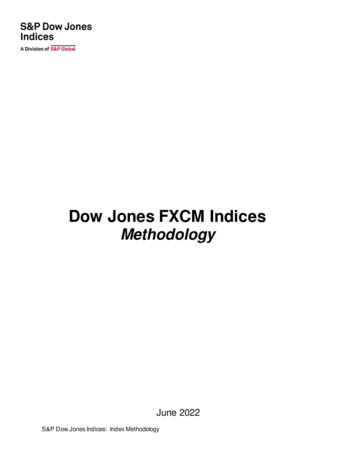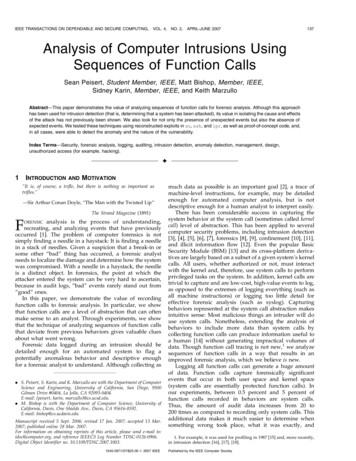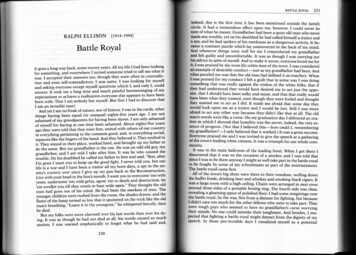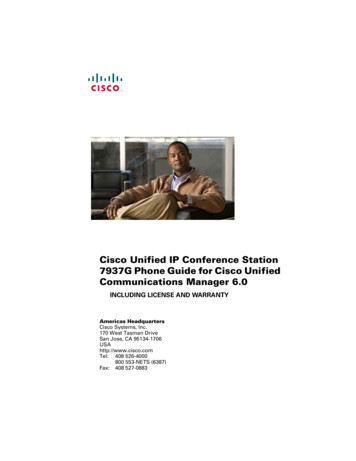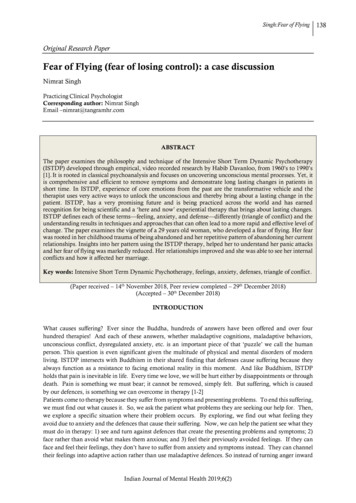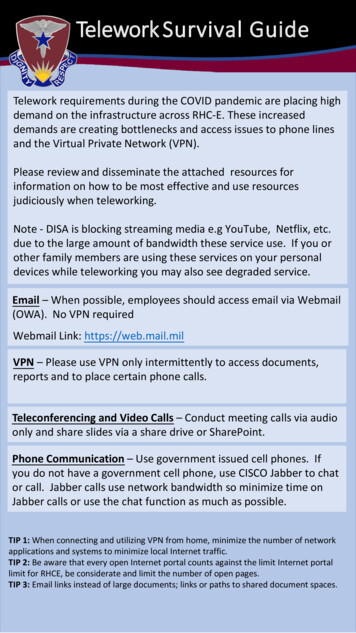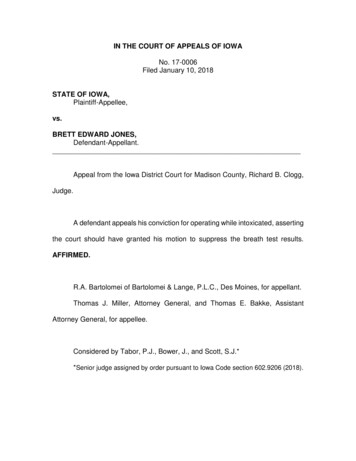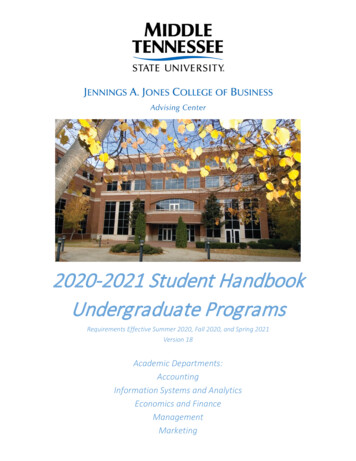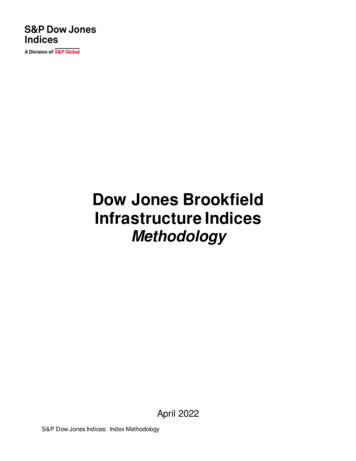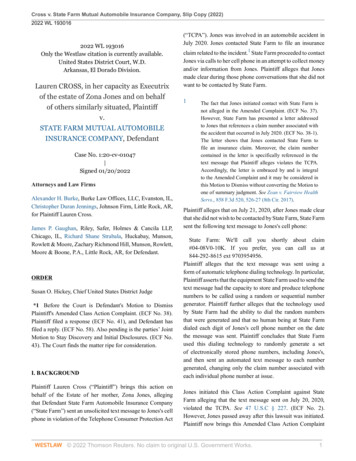
Transcription
Cross v. State Farm Mutual Automobile Insurance Company, Slip Copy (2022)2022 WL 1930162022 WL 193016Only the Westlaw citation is currently available.United States District Court, W.D.Arkansas, El Dorado Division.Lauren CROSS, in her capacity as Executrixof the estate of Zona Jones and on behalfof others similarly situated, Plaintiffv.STATE FARM MUTUAL AUTOMOBILEINSURANCE COMPANY, DefendantCase No. 1:20-cv-01047 Signed 01/20/2022Attorneys and Law FirmsAlexander H. Burke, Burke Law Offices, LLC, Evanston, IL,Christopher Duran Jennings, Johnson Firm, Little Rock, AR,for Plaintiff Lauren Cross.James P. Gaughan, Riley, Safer, Holmes & Cancila LLP,Chicago, IL, Richard Shane Strabala, Huckabay, Munson,Rowlett & Moore, Zachary Richmond Hill, Munson, Rowlett,Moore & Boone, P.A., Little Rock, AR, for Defendant.ORDERSusan O. Hickey, Chief United States District Judge*1 Before the Court is Defendant's Motion to DismissPlaintiff's Amended Class Action Complaint. (ECF No. 38).Plaintiff filed a response (ECF No. 41), and Defendant hasfiled a reply. (ECF No. 58). Also pending is the parties’ JointMotion to Stay Discovery and Initial Disclosures. (ECF No.43). The Court finds the matter ripe for consideration.I. BACKGROUNDPlaintiff Lauren Cross (“Plaintiff”) brings this action onbehalf of the Estate of her mother, Zona Jones, allegingthat Defendant State Farm Automobile Insurance Company(“State Farm”) sent an unsolicited text message to Jones's cellphone in violation of the Telephone Consumer Protection Act(“TCPA”). Jones was involved in an automobile accident inJuly 2020. Jones contacted State Farm to file an insuranceclaim related to the incident.1 State Farm proceeded to contactJones via calls to her cell phone in an attempt to collect moneyand/or information from Jones. Plaintiff alleges that Jonesmade clear during those phone conversations that she did notwant to be contacted by State Farm.1The fact that Jones initiated contact with State Farm isnot alleged in the Amended Complaint. (ECF No. 37).However, State Farm has presented a letter addressedto Jones that references a claim number associated withthe accident that occurred in July 2020. (ECF No. 38-1).The letter shows that Jones contacted State Farm tofile an insurance claim. Moreover, the claim numbercontained in the letter is specifically referenced in thetext message that Plaintiff alleges violates the TCPA.Accordingly, the letter is embraced by and is integralto the Amended Complaint and it may be considered inthis Motion to Dismiss without converting the Motion toone of summary judgment. See Zean v. Fairview HealthServs., 858 F.3d 520, 526-27 (8th Cir. 2017).Plaintiff alleges that on July 21, 2020, after Jones made clearthat she did not wish to be contacted by State Farm, State Farmsent the following text message to Jones's cell phone:State Farm: We'll call you shortly about claim#04-08V0-10K. If you prefer, you can call us at844-292-8615 ext 9703954956.Plaintiff alleges that the text message was sent using aform of automatic telephone dialing technology. In particular,Plaintiff asserts that the equipment State Farm used to send thetext message had the capacity to store and produce telephonenumbers to be called using a random or sequential numbergenerator. Plaintiff further alleges that the technology usedby State Farm had the ability to dial the random numbersthat were generated and that no human being at State Farmdialed each digit of Jones's cell phone number on the datethe message was sent. Plaintiff concludes that State Farmused this dialing technology to randomly generate a setof electronically stored phone numbers, including Jones's,and then sent an automated text message to each numbergenerated, changing only the claim number associated witheach individual phone number at issue.Jones initiated this Class Action Complaint against StateFarm alleging that the text message sent on July 20, 2020,violated the TCPA. See 47 U.S.C § 227. (ECF No. 2).However, Jones passed away after this lawsuit was initiated.Plaintiff now brings this Amended Class Action Complaint 2022 Thomson Reuters. No claim to original U.S. Government Works.1
Cross v. State Farm Mutual Automobile Insurance Company, Slip Copy (2022)2022 WL 193016(“Complaint”) on behalf of the estate of Jones as well asall others similarly situated. (ECF No. 37). Defendant nowmoves the Court to dismiss the Complaint pursuant to FederalRule of Civil Procedure 12(b)(1) and 12(b)(6).State Farm argues that Plaintiff's Complaint should bedismissed: (1) for lack of standing; (2) for failure to state aclaim upon which relief can be granted; and (3) because theTCPA violation alleged did not survive Jones's death. TheCourt will consider each matter in turn.II. STANDARDA. StandingArticle III of the United States Constitution limits judicialpower to decide “Cases” and “Controversies.” U.S. Const.art. III, §§ 1-2; see also Lujan v. Defs. of Wildlife, 504U.S. 555, 560, 112 S.Ct. 2130, 119 L.Ed.2d 351 (1992). Toestablish Article III standing under the case and controversyrequirement, “[t]he plaintiff must have (1) suffered an injuryin fact, (2) that is fairly traceable to the challenged conductof the defendant; and (3) that is likely to be redressed bya favorable judicial decision.” Spokeo Inc. v. Robins, 578U.S. 330, 338, 136 S.Ct. 1540, 194 L.Ed.2d 635 (2016). Toestablish an injury in fact, the plaintiff must have suffered aninjury which is both concrete and particularized. Id. at 339,136 S.Ct. 1540. “A concrete injury must be de facto; that is,it must actually exist.” Id. at 340, 136 S.Ct. 1540.*2 A party may move to dismiss an action for lack of subjectmatter jurisdiction as well as for failure to state a claim uponwhich relief can be granted. Fed. R. Civ. P. 12(b)(1), 12(b)(6). To survive a motion to dismiss under Rule 12(b)(6), apleading must provide “a short and plain statement of theclaim that the pleader is entitled to relief.” Fed. R. Civ. P. 8(a)(2). The purpose of this requirement is to “give the defendantfair notice of what the . claim is and the grounds upon whichit rests.” Erickson v. Pardus, 551 U.S. 89, 93, 127 S.Ct. 2197,167 L.Ed.2d 1081 (2007) (quoting Bell Atl. Corp. v. Twombly,550 U.S. 544, 555, 127 S.Ct. 1955, 167 L.Ed.2d 929 (2007)).The factual allegations of a complaint are assumed true andall reasonable inferences are drawn in the plaintiff's favor,“even if it strikes a savvy judge that actual proof of thosefacts is improbable.” Twombly, 550 U.S. at 555-56, 127 S.Ct.1955. A court, however, need not “blindly accept the legalconclusions drawn by the pleader from the facts.” Westcott v.City of Omaha, 901 F.2d 1486, 1488 (8th Cir. 1990).The complaint “must contain sufficient factual matter,accepted as true, to ‘state a claim to relief that is plausibleon its face.’ ” Ashcroft v. Iqbal, 556 U.S. 662, 678, 129 S.Ct.1937, 173 L.Ed.2d 868 (2009) (quoting Twombly, 550 U.S. at570, 127 S.Ct. 1955). “A claim has facial plausibility whenthe plaintiff pleads factual content that allows the court todraw the reasonable inference that the defendant is liable forthe misconduct alleged.” Id. “A pleading that offers ‘labelsand conclusions’ or ‘a formulaic recitation of the elements ofa cause of action will not do.’ Nor does a complaint sufficeif it tenders ‘naked assertions’ devoid of ‘further factualenhancement.’ ” Id. (internal citations and alterations omitted)(quoting Twombly, 550 U.S. at 555, 557, 127 S.Ct. 1955).In other words, “the pleading standard Rule 8 announcesdoes not require ‘detailed factual allegations,’ but it demandsmore than an unadorned, the-defendant-unlawfully-harmedme accusation.” Id. (quoting Twombly, 550 U.S. at 555, 127S.Ct. 1955).III. DISCUSSIONThe issue presented in the instant Motion is whether thereceipt of a single unsolicited text message is sufficient toconfer Article III standing to pursue a cause of action underthe TCPA. On this point, State Farm argues that Jones's receiptof a single text message, in response to an insurance claiminitiated by Jones herself, is not a concrete injury for thepurposes of Article III standing. Neither the Supreme Courtnor the Eighth Circuit has squarely addressed whether thereceipt of a single text message is sufficient to establish aconcrete injury in fact under the TCPA. Because of this, theparties have spent considerable time discussing cases fromother jurisdictions that discuss Article III standing withinthe context of the TCPA. These cases illustrate a clear splitin circuit court authority regarding whether the receipt of asingle text message is sufficient to confer Article III standingto pursue a TCPA claim.*3 Based on the foregoing, the Court must first determinewhat standards govern its standing analysis. As stated above,the Eighth Circuit has not specifically addressed whetherthe receipt of a single text message is sufficient to conferArticle III standing to pursue a TCPA claim. However, theEighth Circuit has answered the similar question of whether aplaintiff has Article III standing to pursue a TCPA claim basedupon the receipt of two unsolicited phone calls. See Golanv. FreeEats.com, Inc., 930 F.3d 950, 958 (8th Cir. 2019).The Court is obligated to adopt a standing analysis that best 2022 Thomson Reuters. No claim to original U.S. Government Works.2
Cross v. State Farm Mutual Automobile Insurance Company, Slip Copy (2022)2022 WL 193016conforms to Eighth Circuit precedent. See e.g. Cain v. NevadaCounty School Dist., No. 4:10-cv-04011, 2011 WL 6370082,at *4 (W.D. Ark. Dec. 20, 2011). However, before turning tothe issue of what standing analysis the Court should apply,the Court must first outline the specific harms sought to beredressed through the TCPA generally.1. Concrete Injury Under the TCPACongress passed the TCPA in 1991 to address the nuisanceand intrusions caused by the increasing number of prerecorded and unsolicited calls that were being made toresidential telephones. See e.g. Barr v. American Associationof Political Consultants, Inc., 591 U.S. ––––, 140 S. Ct.2335, 2344, 207 L.Ed.2d 784 (2020). To address this issue,the TCPA made it unlawful for telemarketers to use “anyautomatic telephone dialing system” (“ATDS”) to contact aperson's cell phone without “the prior express consent of thecalled party[.]” 47 U.S.C. § 227(b)(1)(A). The TCPA creates aprivate cause of action for individuals who receive messagesvia an ATDS in violation of the Act. 47 U.S.C. § 227(b)(3).Although the TCPA itself does not specifically prohibit theuse of an ATDS to send automated text messages, the FCChas used its rulemaking authority to apply the statute to textmessages. See Salcedo v. Hanna, 936 F.3d 1162, 1166 (11thCir. 2019); see also Campbell-Ewald Co. v. Gomez, 577 U.S.153, 156, 136 S.Ct. 663, 193 L.Ed.2d 571 (2016) (stating that“[a] text message to a cellular telephone, it is undisputed,qualifies as a ‘call’ within the compass of [the TCPA]”).22The Court notes that Gomez is unclear as to whether theSupreme Court intended this language to be a declarationthat a text message is considered a “call” within themeaning of the TCPA in all instances, or instead whetherthe Supreme Court was merely acknowledging that theissue was not challenged in the present lawsuit. However,district courts in the Eighth Circuit have cited Gomez forthe proposition that a text message is a call under theTCPA and the issue is not challenged here. See Gouldv. Farmers Ins. Exch., 288 F. Supp.3d 963, 967 (E.D.Mo. 2018); Yashtinsky v. Walmart, Inc., Case No. 5:19cv-5105, 2019 WL 5986708, at *2 (W.D. Ark. Nov. 12,2019).The harms addressed by Congress through the TCPA areintangible injuries, which although harder to recognize ina straightforward standing analysis, “can nevertheless beconcrete.” Spokeo, 578 U.S. at 340, 136 S.Ct. 1540. However,“[a] plaintiff does not ‘automatically satisf[y] the injury-infact requirement whenever a statute grants a person a statutoryright and purports to authorize that person to sue to vindicatethat right.’ ” Golan, 930 at 958 (quoting Spokeo, 578 U.S.at 341, 136 S.Ct. 1540). Indeed, as this Court has previouslyobserved, “a concrete injury does not automatically flow fromCongress's identification of a harm, and the concretenessrequirement is still present even in the context of a statutoryviolation.” Kelly v. Lindsey Mgmt. Co., Inc., 4:15-cv-04035,2017 WL 10129164, at *2 (W.D. Ark. 2017) (citing Spokeo,578 U.S. at 341, 136 S.Ct. 1540).When a plaintiff asserts harm to an intangible interest,courts look to “both history and the judgment of Congress”to determine whether the injury complained of constitutesa concrete injury in fact under Article III. Spokeo, 578U.S. at 340, 136 S.Ct. 1540. Under this approach, theSupreme Court has stated that “it is instructive [for courts]to consider whether an alleged intangible harm has a closerelationship to a harm that has traditionally been regardedas providing a basis for a lawsuit in English or Americancourts.” Id. The Supreme Court has further explained thatCongress is particularly suited “to identify intangible harmsthat meet minimum Article III requirements” and therefore“its judgment is . instructive and important.” Id.*4 The parties agree that the Court must consider bothhistory and Congress's intent in passing the TCPA todetermine whether Jones's receipt of a single text messagepresents a sufficient injury in fact to confer standing to pursuea TCPA claim. However, the parties disagree as to the mannerin which history and intent should be applied to the factspresented. Indeed, State Farm cites to the Salcedo case outof the Eleventh Circuit to argue that the receipt of a singleunwanted text message poses a diminished injury such that itwould not have been recognized under English common lawand should therefore be rejected here. In response, Plaintiffargues that the Court should reject Salcedo because it divergesfrom Eighth Circuit precedent and has been specificallyrejected by a number of other circuits. Instead, Plaintiffasserts that the Court's standing analysis should focus onlyon whether the harm of a single unsolicited text message isrelated to the kind of harms that were recognized at commonlaw, without regard to the actual severity of the harm alleged.Accordingly, the Court must consider the Eleventh Circuit'sopinion in Salcedo to determine whether it conforms ordeparts from Eighth Circuit precedent.a. Salcedo 2022 Thomson Reuters. No claim to original U.S. Government Works.3
Cross v. State Farm Mutual Automobile Insurance Company, Slip Copy (2022)2022 WL 193016In Salcedo, a Florida attorney sent plaintiff, a former client ofthe attorney, an unsolicited text message which offered a tenpercent discount for the attorney's services. Salcedo, 936 F.3dat 1165. Plaintiff filed suit alleging violation of the TCPA,and defendant moved to dismiss the action on the groundsthat a single text message was not a concrete injury in fact forthe purposes of Article III standing. Id. The court in Salcedospecifically addressed whether the judgment of Congress andhistory rendered the receipt of a single text message as asufficient injury in fact for the purpose of Article III standing.Id. at 1168.Regarding the judgment of Congress, the Eleventh Circuitnoted that Congress said “nothing” in the TCPA on the subjectof unsolicited text messages, and observed that Congress'sjudgment on the subject “is ambivalent at best[.]” Id. at1169. The court also observed that the Act primarily regulatesunsolicited phone calls made to residential rather than mobilephones. Id. Because of this, the Court found that Congress'sprimary concern in passing the TCPA was to address theharms associated with “intrusive invasions of privacy intothe home[.]” Id. at 1170. In reaching this conclusion, thecourt found persuasive that text messages “will not alwaysinvolve an intrusion into the privacy [of] the home” becausea cell phone is portable and capable of being silenced.Id. Accordingly, the Court held that “[t]he judgment ofCongress . provides little support for finding that [Plaintiff's]allegations state a concrete injury in fact.” Id.Turning to the question of history, the Eleventh Circuitspecifically compared Plaintiff's alleged injury to the acceptedcommon law torts of intrusion upon seclusion, nuisance,conversion, and trespass to chattel. Id. at 1170-71. Withregard to intrusion upon seclusion, the court held thata single text message to a private cell phone was notclosely related to the severe kinds of intrusions that thetort would have traditionally recognized as actionable, suchas wiretapping, eavesdropping, and looking through one'spersonal documents. Id. at 1171 (citing Restatement (Second)of Torts § 652B). With regard to nuisance, the court heldthat a single text message to a cell phone did not impact thesort of real property rights that would ordinarily be requiredto sustain a nuisance cause of action. Id. Then, turning tothe personal property torts such as conversion and trespassto chattel, the court again concluded that “[h]istory showsthat [plaintiff's] allegation” of receiving a single unsolicitedtext message “is precisely the kind of fleeting infraction uponpersonal property that tort law has resisted addressing.” Id.at 1172. Based on these observations, the Eleventh Circuitheld that the receipt of a single unsolicited text message failsto satisfy the injury in fact requirement necessary to conferArticle III standing to pursue a TCPA claim. Id. at 1172-73.State Farm urges the Court to adopt the approach takenby the Eleventh Circuit in Salcedo and find that Jones'sreceipt of a single unsolicited text message is insufficientto confer Plaintiff Article III standing to pursue this TCPAclaim. In response, Plaintiff cites case law from other circuitswhich have either expressly or by implication rejectedSalcedo’s reliance on the severity of the harm alleged inits standing analysis. As noted above, the Eighth Circuithas not squarely addressed whether the receipt of a singletext message constitutes a concrete injury in fact underArticle III. Accordingly, the Court must outline the EighthCircuit's approach to standing under the TCPA generally andthen determine whether either Salcedo or the cases citedby Plaintiff better conforms to established Eighth Circuitprecedent.i. Salcedo and Eighth Circuit Precedent*5 Plaintiff argues that the Court should reject Salcedobecause it conflicts with the Eighth Circuit's approach tostanding as adopted in Golan. In Golan, the Eighth Circuitheld that plaintiffs had established a sufficient concreteinjury in fact to pursue a TCPA claim when they allegedlyreceived two unsolicited and pre-recorded voicemails on theiranswering machines. Golan, 930 F.3d at 957-59. Specifically,the plaintiffs in Golan received two pre-recorded messagesthat stated: “Liberty. This was a public survey call. Wemay call back later.” Id. at 955. The calls were placed aspart of a nationwide advertising campaign that was designedto promote a niche political film by targeting those whopotentially aligned with the film's ideological message. Id.The Eighth Circuit held in Golan that the two unsolicitedand prerecorded phone calls were sufficient to confer ArticleIII standing because the harms associated with receiving thetelemarketing messages “b[oar] a close relationship to thetypes of harms traditionally remedied by tort law, particularlythe law of nuisance.” Id. at 959. Unlike the EleventhCircuit in Salcedo, the court in Golan did not considerwhether the harm suffered was of sufficient severity to conferstanding. Moreover, the Golan decision did not offer any realcomparison between the harms alleged by plaintiffs and thoseredressed by the traditional common law tort of nuisance.Instead, the Eighth Circuit held generally that Congress had 2022 Thomson Reuters. No claim to original U.S. Government Works.4
Cross v. State Farm Mutual Automobile Insurance Company, Slip Copy (2022)2022 WL 193016elevated the status of the harms associated with unsolicitedtelephone calls to such a degree that the minimal harmspresented were now sufficient to establish a concrete injuryin fact. Id. at 959.In addition to Golan, Plaintiff argues that the Court shouldalso disregard Salcedo because various other courts haverejected its reliance on the severity of the harm allegedto determine standing. Instead, Plaintiff urges the Court toconsider only whether the harms she alleges under the TCPAare similar to the kind of harms that were cognizable bycommon law courts. In support, Plaintiff cites a SeventhCircuit opinion, authored by then Circuit Judge Amy ConeyBarrett, where the court specifically rejected Salcedo andfound that the receipt of five unsolicited text messages wassufficient to confer Article III standing.3 See Gadelhak v.AT&T Services, Inc., 950 F.3d 458, 462-63 (7th Cir. 2020).3Specifically, the plaintiff in Gadelhak received five textmessages from AT&T even though he was not an AT&Tcustomer. See Gadelhak, 950 F.3d at 460.In Gadelhak, the Seventh Circuit observed that the commonlaw tort of intrusion upon seclusion involved some level ofredress for irritating intrusions, “such as when telephone callsare repeated with such persistence and frequency as to amountto a course of hounding the plaintiff.” Id. at 462 (quotationsomitted). Thus, the court held that the receipt of unsolicitedtext messages conferred Article III standing because the“harm posed by unwanted text messages is analogous to thattype of intrusive invasion of privacy.” Id. In its decision,the Seventh Circuit specifically rejected Salcedo and itsconsideration of whether that harm was of a sufficient severityso as to confer standing. Id. Instead, the Seventh Circuit foundthat unsolicited text messages were a concrete injury in factunder Article III because unwanted text messages “pose thekind of harm that common law courts recognize[,]” and thusconstituted “a concrete harm that Congress has chosen tomake legally cognizable.” Id. at 463 (emphasis in original).Gadelhak is premised on the idea that when courts look towhether a harm is grounded in common law traditions, it ismeant to look for whether the harm alleged bears a closerelationship to the kind of harm redressed by common lawtorts, not the degree or severity. Id. at 462 (citing Spokeo,578 U.S. at 341, 136 S.Ct. 1540). Under this approach, thecommon law “does not stake out the limits of Congress'spower to identify harms deserving a remedy[.]” Id. at463. Instead, Congress may elevate previously unrecognizedharms into legally cognizable and concrete injuries. Id.Therefore, under Gadelhak, the receipt of a single unsolicitedtext message would constitute a concrete injury in fact underArticle III if it poses a risk of harm that is similar to thoserecognized at common law, and Congress intended to elevatethat harm into a legally cognizable injury. The Court notesthat the rationale outlined in Gadelhak has been adoptedby all other circuits, other than the Eleventh Circuit, whichhave addressed the issue of standing under the TCPA. SeeCranor v. 5 Star Nutrition, LLC, 998 F.3d 686, 690-91 (5thCir. 2021) (expressly rejecting Salceno and holding that theharms associated with unsolicited text messages are bothregulated by the TCPA and closely related in kind to thosetraditionally recognized at common law); Melito v. ExperianMktg. Sols., Inc., 923 F.3d 85, 93 (2nd Cir. 2019) (holdingthat the receipt of unsolicited spam text messages were “thevery injury” the TCPA is designed to prevent and that suchbears a close relationship to harms traditionally redressed atcommon law); Susinno v. Work Out World Inc., 862 F.3d 346,351 (3rd Cir. 2017) (holding that “nuisance and invasion ofprivacy” arising out of a single prerecorded telephone call are“the very harm that Congress sought to prevent”); Van Pattenv. Vertical Fitness Grp., LLC, 847 F.3d 1037, 1043 (9th Cir.2017) (holding that a plaintiff need not allege any additionalharm beyond an invasion of privacy or disruption of solitudeto establish standing under the TCPA).*6 In addition to these Circuit Court cases, Plaintiff alsopoints out that the United States District Court for theWestern District of Arkansas has relied on Golan to conferArticle III standing upon a plaintiff who allegedly receivedtwo unsolicited text messages in violation of the TCPA.See Yashtinsky v. Walmart, No. 5:19-cv-5105, 2019 WL5986708, at *1 (W.D. Ark. Nov. 12, 2019). The courtin Yashtinsky held that because cell phones are such apervasive presence in modern life, unwanted text messagesare arguably more intrusive than unanswered messages lefton answering machines. Id. at 2. The court also observedthat unwanted text messages waste a quantifiable amountof data on the recipient's cell phone, temporarily reduce theavailable computing power and application processing speedon the recipient's phone, and require expending a quantifiableamount of energy to recoup the battery power lost as a resultof receiving the text message. Id. Accordingly, the courtconcluded that the receipt of two text messages, as well as theattendant injuries alleged, were sufficient to establish ArticleIII standing under the TCPA. Id.Based on the foregoing, the Court finds that the approacharticulated by the Seventh Circuit in Gadelhak is substantially 2022 Thomson Reuters. No claim to original U.S. Government Works.5
Cross v. State Farm Mutual Automobile Insurance Company, Slip Copy (2022)2022 WL 193016similar to the Eighth Circuit's decision in Golan and shouldtherefore be adopted here. Like Gadelhak, the Eighth Circuitin Golan recognized that the TCPA regulates the unwantedintrusion and nuisance related to unsolicited contact viaphone. Golan, 930 F.3d at 959. Moreover, Golan appearsto specifically adopt Gadelhak’s reasoning that “[i]t is notdispositive whether unsolicited telephone calls are actuallyactionable under any common law tort because Congress mayelevate” previously inadequate harms into legally cognizableand concrete injuries. Compare Golan, 930 F.3d at 959, withGadelhak, 950 F.3d at 462-63 (holding that “while commonlaw offers guidance, it does not stake out the limits ofCongress's power to identify harms deserving a remedy”).Indeed, the Eighth Circuit's holding in Golan did not turn onwhether the harm alleged was similar in degree or severity tothe harms that were recognized at common law. Accordingly,the Court declines to adopt Salcedo because it is a cleardeparture from Eighth Circuit precedent. Instead, the Courtadopts the approach to Article III standing as articulated bythe Seventh Circuit in Gadelhak.Now, having determined that the approach outlined inGadelhak specifically applies to this case, the Court must turnto the facts presented to determine whether the receipt of asingle unsolicited text message is similar to the kind of harmsrecognized at common law and whether Congress intended toelevate that harm into a concrete injury in fact for the purposeof Article III standing.b. Common Law Harm and Congressional IntentThe Eighth Circuit has recognized that the “harm to beremedied by the TCPA was ‘the unwanted intrusion andnuisance of unsolicited telemarketing phone calls and faxadvertisements.’ ” Golan, 930 F.3d at 959 (quoting VanPatten, 847 F.3d at 1043). Although the Eighth Circuit hasnot applied the TCPA specifically to text messages, theFifth Circuit has recently observed that, to the exclusionof the Eleventh Circuit, its “sister circuits have reached thesame conclusion: ‘[T]elemarketing text messages present theprecise harm and infringe on the same privacy interestsCongress sought to protect in enacting the TCPA.’ ” Cranor,998 F.3d at 690 (collecting cases). Indeed, a number ofcourts have specifically held that the TCPA addresses harmsthat are related in kind to harms that were traditionallyredressed through common law torts. See generally id. at691 (finding that the harms addressed by the TCPA bears aclose relationship to the common law tort of public nuisance);Galhadak, 950 F.3d at 462 (finding that the harms addressedby the TCPA are “analogous” to the harms redressed by thecommon law tort of intrusion upon seclusion); Melito, 923F.3d at 93 (finding that the harms addressed by the TCPA beara close relationship to the common law torts of invasions ofprivacy, intrusion upon seclusion, and nuisance).*7 Based on the forgoing, the Court finds that the receiptof a single unsolicited text message is sufficient to conferArticle III standing under the TCPA. However minimal,unsolicited text messages pose both a nuisance and unwantedintrusion into one's life. This harm is related in-kind tothose harms traditionally redressed through the common lawtorts of nuisance and intrusion upon seclusion. Moreover,it is immaterial that Plaintiff seeks redress for the receiptof a single unsolicited text message. Distinguishing betweenthe harms suffered by the receipt of one versus multipleunsolicited text messages would supplant the proper “similarin-kind” analysis with one that improperly questions whetherthe harm suffered is sufficiently severe. Indeed, Congress mayelevate harms that were previously unactionable at commonlaw and has done so with respect to the annoyance andintrusion alleged by Plaintiff. Therefore, based on the case lawoutlined above, the Court finds that Jones's receipt of a singleunsolicited text message is sufficient to confer Article IIIstanding under the TCPA. Accordingly, State Farm's Motionto Dismiss based upon lack of standing should be denied.B. Failure to State a ClaimState Farm next argues that the Complaint should also bedismissed because it fails to allege facts sufficient to state aplausible cause of action under the TCPA. As stated above, theTCPA makes it unlawful to “make any call (other than a callmade for emergency purposes or made with the prior expressconsent of the called party) using any [ATDS].” 47 U.S.C.§ 227(b)(1)(A). The TCPA defines an ATDS as “equipmentwhich has the capacity--(A) to store or produce telep
1 The fact that Jones initiated contact with State Farm is not alleged in the Amended Complaint. (ECF No. 37). However, State Farm has presented a letter addressed to Jones that references a claim number associated with the accident that occurred in July 2020. (ECF No. 38-1). The letter shows that Jones contacted State Farm to file an insurance .
